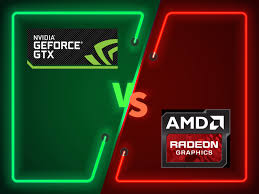It surely isn't possible to name a war more stimulating than the long standing NVidia vs AMD war.

Ever since August 31, 1999 when NVidia released their first GeForce graphics card, The NVidia GeForce 256 (NV10) GPU, It has been dominating the graphics card scenario in the pc world with its extremely powerful high performance GPU's. It is safe to say that NVidia has always been more powerful than its sole competitor, AMD Radeon GPU's. Their clock speeds have broken all charts and people experiment with various GeForce GPU's.
NVidia is an American multinational technology company that designs graphics processing units for the gaming and professional market.
Advanced Micro Devices is also another American multinational semiconductor that designs computer processors and graphics processing units.
AMD also makes a fair share of powerful CPU's that compete with those of Intel.
AMD Has been known for its price, which they like to keep low and purchasable to the common public who do not want to spend a fortune while making a computer. Even though NVidia GPU's are high more popular and they have very high prices. NVidia GPU's are for the people who want the maximum performance in their systems.
NVidia makes 2 kinds of GPU's. First comes their GeForce GTX / RTX series that specialize in gaming with high clock speeds and tons of VRAM to support modern triple A games with ease. The new RTX series features a new aspect to gaming. Ray Tracing. Ray Tracing makes the Local lights in a game look extremely realistic and give it a completely different effect. In the early stage of Ray Tracing on some less powerful RTX GPU's, performance was degraded a lot and sometimes frames were lost up to 60%. However, with the new inclusion of DLSS 2.0, these problems don't arise quite frequently and it's safe to say that NVidia has countered the issue well.
A very deciding factor between NVidia and AMD GPU's are their drivers. Drivers are the software part of the GPU's which may or may not improve the GPU's performance and fix issues. AMD has been notoriously known for having inconsistent drivers that fail to perform well compared to the optimized drivers that NVidia equips its GPU's with.
As of now the only competition between these two is the NVidia GeForce RTX vs AMD Radeon RX Series. For the professional workload NVidia has a Quadro Series lined up at extremely high prices with enormous amounts of VRAM and Cuda cores which help professionals do tasks from Video Editing to training AI's to Data Mining and much more. AMD Has its own professional use GPU known as the Vega Series.
Another deciding factor is the price of these GPU's. The most expensive RTX card is the NVidia Titan RTX at a price of Rs.2,41,000 While the most expensive AMD GPU is the Radeon WX 9100 at Rs.1,19,962. Almost half the price of the Titan RTX. Some NVidia Quadros can also go up to 5000$ or Rs.3,74,600. A normal gaming GPU from NVidia can cost from 300-1200$ but AMD stays true to its prices which are much lower than those from NVidia .
However, it's not easy to generalize on this subject without taking into account a modelwise comparison. Let's compare Nvidias RTX 2080 Ti, GTX 1660 Ti and Quadro RTX 8000 to Amds Radeon RX 5700XT, Radeon RX 560 and Radeon RX Vega 64 respectively.